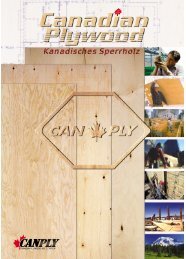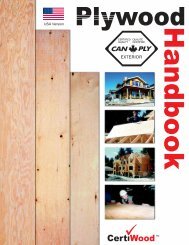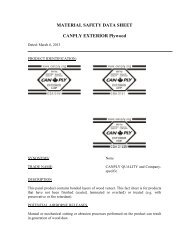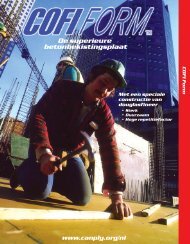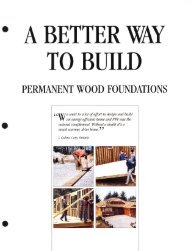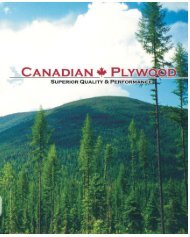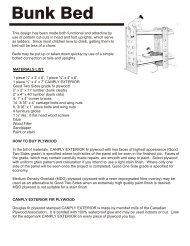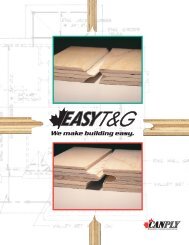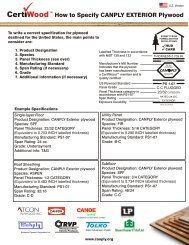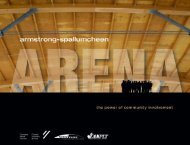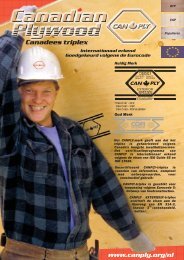Plywood Design Fundamentals - Canadian Plywood Association
Plywood Design Fundamentals - Canadian Plywood Association
Plywood Design Fundamentals - Canadian Plywood Association
You also want an ePaper? Increase the reach of your titles
YUMPU automatically turns print PDFs into web optimized ePapers that Google loves.
2012_april revised_48945_en_design.qxd 19/04/2012 3:04 PM Page 19<br />
Table 16. load Duration Factor (K D )<br />
Duration of<br />
loading<br />
Short Term<br />
Standard Term<br />
Permanent<br />
K D<br />
1.15<br />
1.00<br />
0.65<br />
19<br />
Explanatory Notes<br />
Short term loading means that condition of loading where the duration of the specified loads is not expected to<br />
last more than seven days continuously or cumulatively throughout the life of the structure.<br />
Examples include wind loads, earthquake loads, falsework and formwork as well as impact loads.<br />
Standard term means that condition of loading where the duration of specified loads exceeds that of short<br />
term loading, but it is less than permanent permanent loading.<br />
Examples include snow loads, live loads due to occupancy, wheel loads on bridges and dead loads in combination<br />
with all of the above.<br />
Permanent duration means that condition of loading under which a member is subject to more or less continuous<br />
specified load.<br />
Examples include dead loads plus live loads of such character that they are imposed on the members for as<br />
long a period of time as the dead loads themselves. Such loads include those usually occurring in tanks or<br />
bins containing fluids or granular material, loads on retaining walls subject to lateral pressure such as earth,<br />
floor loads where the specified load may be expected to be continuously applied such as those in buildings for<br />
storage of bulk materials. Loads due to fixed machinery should be considered permanent.<br />
Notes:<br />
1. Duration of load may require professional judgement by the designer. explanatory notes in this table provide guidance to designers<br />
about the types of loads and load combinations for which each modification factor should be applied to tabulated specified strengths,<br />
in accordance with CsA O86 engineering <strong>Design</strong> in Wood.<br />
2. For standard term loads where D is greater than L, the permanent load factor may be used, or the factor may be calculated as:<br />
( )<br />
KD =1.0-0.50 log<br />
D<br />
> 0.65<br />
L<br />
where L = specified live load<br />
D = specified dead load<br />
3. When the total specified load is made up of loads acting for different durations, the design shall be based on the most severe<br />
combination. The appropriate load duration factor shall be taken into account for each load combination.<br />
Table 17. Service Condition Factor (K S)<br />
Property to be Modified<br />
Specified Strength<br />
Specified Stiffness and Rigidity<br />
Service Condition<br />
Dry<br />
1.0<br />
1.0<br />
Table 18. Stress Joint Factor (X J) for Butt Joints<br />
Unsanded<br />
<strong>Plywood</strong><br />
Thickness<br />
(mm)<br />
7.5<br />
9.5<br />
12.5<br />
15.5 to 20.5<br />
Minimum Length of<br />
Splice Plate<br />
Perpendicular to<br />
Joint (mm)<br />
200<br />
300<br />
350<br />
400<br />
Wet<br />
0.80<br />
0.85<br />
Tension<br />
Splice Plate Compression<br />
One Both and Shear<br />
Side Sides<br />
0.67 0.85 1.0<br />
0.67 0.85 1.0<br />
0.67 0.85 1.0<br />
0.50 0.85 1.0<br />
Table 19. Stress Joint Factor (X J) for Scarf Joints<br />
Slope of Scarf<br />
1:12<br />
1:10<br />
1:8<br />
1:5<br />
Tension<br />
0.85<br />
0.80<br />
0.75<br />
0.60<br />
Compression<br />
1.0<br />
1.0<br />
1.0<br />
1.0<br />
Shear<br />
1.0<br />
1.0<br />
1.0<br />
Not allowable<br />
certiWood Canply plywood <strong>Design</strong> <strong>Fundamentals</strong>



